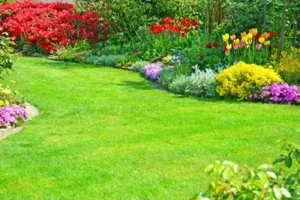 Want a beautiful, green, lush lawn and fewer weeds? Consider adding fertilizer to it! Just like you need nutrients and water, so does your lawn. Read more to learn how fertilizer can bring back life to your lawn.
Want a beautiful, green, lush lawn and fewer weeds? Consider adding fertilizer to it! Just like you need nutrients and water, so does your lawn. Read more to learn how fertilizer can bring back life to your lawn.
What is Fertilizer?
Fertilizer is comprised of three nutrients:
Nitrogen (N): Nitrogen is a protein in every plant. Nitrogen helps your lawn grow and provides it with that lush green color.
Phosphorous (P): Phosphorous helps seeds sprout and stimulates root growth. If you have new grass, you may want a fertilizer high in phosphorous to stimulate growth.
Potassium (K): Potassium helps grass hold its color and shape. It keeps it healthy-looking. It also helps plants to resist drought and disease.
Fertilizers are all different. You can tell how much of a nutrient is in a bag of fertilizer by a code referred to as the fertilizer grade.
For example, if it says 24-8-16, 24 is the amount of Nitrogen it has, while 8 is the amount of Phosphorous, and 16, the amount of Potassium. They are always read in that order, (NPK).
Types of Lawn Fertilizer
There are an array of options when it comes to lawn fertilizer.
- Organic: compost, manure
- Water-soluble: provide quick release
- Granular: are slow-releasing, you can wait longer between applications
What is the Best Fertilizer for My Lawn?
Here in Florida, we have warm-season grasses including Bermuda, Zoysia, Bahia, Buffalo, Centipede, and St. Augustine. These types of grass go dormant in the winter. If you live further up north, Bentgrass and Kentucky Bluegrass are common. These types of grasses typically remain green year-round and will grow up until winter.
When Should You Fertilize Your Lawn?
If you live in Florida where you have warm-season grass, we recommend having your lawn fertilized in early spring when your grass begins to grow, then again in late spring, and once more in late summer. People with cool-season grass are suggested to fertilize their lawn in the spring and twice during fall.
Can You Over Fertilize Your Lawn?
As with anything else, too much of a good thing can be bad. If too much fertilizer is applied to your lawn, the salt and nitrogen levels in your soil will increase and potentially kill or grass. This is called fertilizer burn. Below are the signs of fertilizer burn.
- Patches of dead grass
- Browning or yellowing of grass
- Withering of grass
A lot of factors come into play when it comes to lawn fertilizer, but choosing the right one and applying it correctly will leave you with a beautiful, thick and green lawn that will have your neighbors green with envy. That’s why it’s important to hire a landscaping company to take care of it all for you. Landscaping contractors know grass, understand the local area, and have the equipment to properly apply your fertilizer. They will also work with you to come up with a schedule so you don’t have to remember when to fertilize your lawn again.

